BRECKENRIDGE, Colorado – The sound of water rushing over football-sized rocks was the predominant background noise as the 2022 Rivian R1T treaded up the steep, slippery trail. There was nothing like the geared-down engine whine or the considerable cooling fan racket expected of a Jeep Wrangler in similar circumstances. Here, the open windows made it easy to pick out the clatter of wet tires contending with loose, muddy rocks – not to mention the chatter of birds looking warily on from neighboring trees.
Rivian's unique electric powertrain was making constant traction-management decisions in response to steady pressure on the accelerator pedal because each of its 34-inch 275/65R20 Pirelli Scorpion All Terrain Plus tires is propelled by its own direct-drive electric motor. The front pair of motors make a combined 415 horsepower and 413 pound-feet of torque, while the rear pair team up for another 420 hp and 495 lb-ft. Peak power was definitely not entering the equation at this point, but the Rivian’s immense torque potential was looming large.
That’s because electric motors produce their maximum torque from zero rpm, which in turn means there’s no need for a low-range transfer case, let alone a transmission. The presence of four traction-managed electric motors makes the idea of driver-selectable front, center and rear differential lockers completely unnecessary, too. Electric motors also give up nothing at altitude, and that mattered here because we were pushing 12,000 feet. The end result was forward progress that was steady, serene and sort of hypnotic over the challenging terrain. If this is what electric off-roading is like, sign me up.
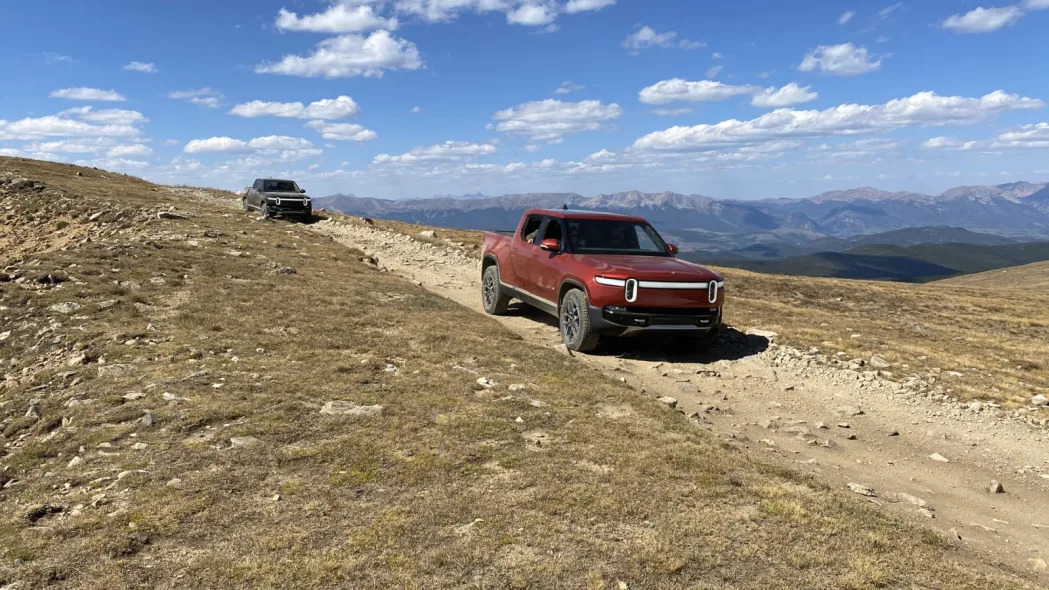


On the pavement, the R1T’s steering feels nicely weighted and reasonably direct, and it's easy to hustle the truck through sweeping bends. Body roll is definitely well-managed, and big 34-inch Pirelli all-terrain tires are remarkably silent. There was more impact harshness on the many frost heaves than is preferred, but unfamiliar roads made this hard to judge. Still, the recommended on-road tire pressure for the Pirellis is a surprisingly high 48 psi. It’s unclear whether the standard 33-inch 275/55R21 tires would have fared better.
Most of my slowing throughout the day was done with lift-throttle regenerative braking, which is fine by me. The R1T has three regen modes, but even the Low setting is fairly strong (0.21g) and works down to a full stop. The Standard setting is stronger than many other EVs at 0.25g, and the Max setting is downright sporty at 0.30g. The real brakes include six-piston Brembo front calipers, but I didn’t regularly use them. The pedal operates the Brembos on a direct basis, so there’s no blending apart from what you get by adding brake force on top of the underlying regen that comes from releasing the accelerator.
The seats proved to be very comfortable and supportive all day, whether bouncing over rocks or hustling through turns. Front-seat head- and legroom were on par with full-sized trucks, but the overhead view of the R1T reveals a Coke-bottle shape that makes the cab narrower than its exterior width specification suggests. It never felt cramped inside, but its interior width is more like a Honda Ridgeline than an F-150. The Rivian’s relatively short overall length of 217.1 inches (versus 232.7 for the F-150 Lightning) does take a nibble out of the rear half of its crew cab, but rear legroom felt similar to that of the family friendly Ridgeline's.
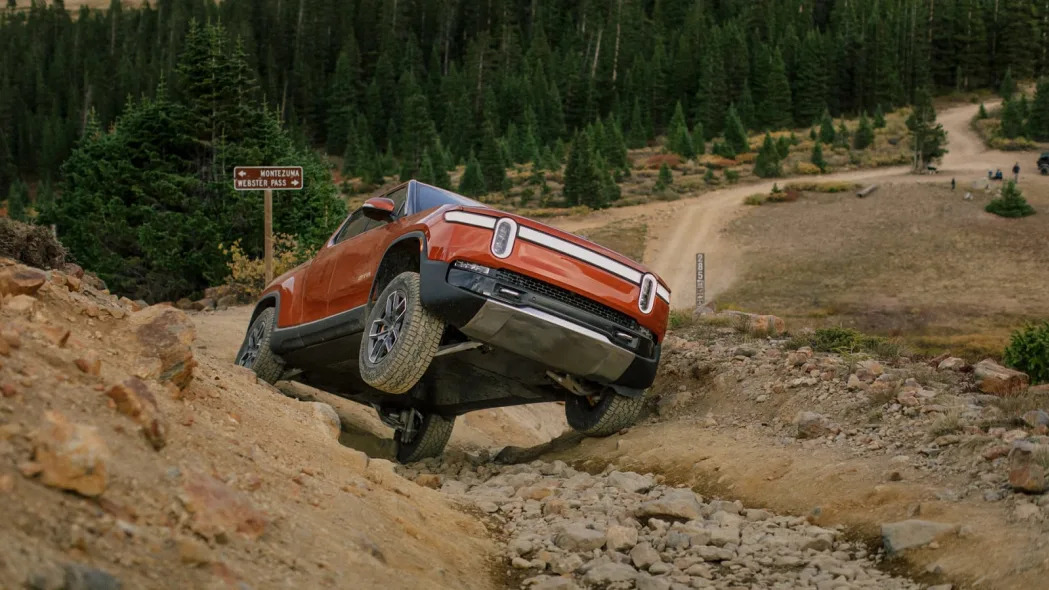

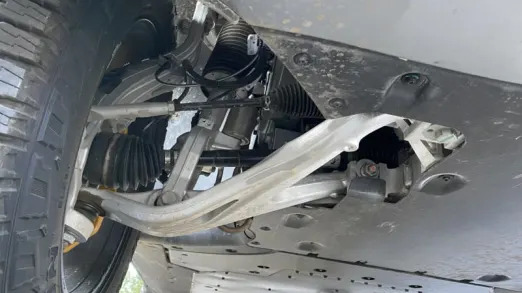
The R1T rides on a four-wheel independent suspension, with double wishbones up front and a unique multilink setup in back. Both ends employ air springs that offer a full 6.5 inches of height adjustment served up in six increments from the lowest kneeling position (only in Park) to the highest “Max” off-road setting. The latter translates into 14.9 inches of ground clearance, more than 3 feet of water fording depth and healthy maximum approach, departure and breakover angles of 34, 29.3 and 25.7 degrees, respectively. I tackled the trail in “High” mode, because 13.1 inches of ground clearance proved to be more than sufficient, especially since the R1T has a pan-flat bottom with no protuberances.
Front and rear suspension travel worked out to 10.2 and 10.6 inches, respectively. That’s quite strong, but the Hummer EV, Ford F-150 Raptor and Ram 1500 TRX offer considerably more because they have between 5 and 6 inches of extra track and body width. Wide-track suspensions make it easier to engineer more wheel travel, but such wide-bodied trucks wouldn’t have fit on this trail (or in many parking spots). The Rivian may have fit, but I had to ease by a few trees at times, and later had to fold in the mirrors to get through a twisting, articulated and steep-walled luge section without breaking them off.
The R1T has no stabilizer bars in the traditional sense. It instead uses a hydraulically interconnected set of adaptive dampers that’s an evolution of a concept I first saw on the McLaren MP4-12C. The Electro-Hydraulic Roll Control system’s left and right dampers are cross-linked rebound-to-compression and compression-to-rebound, while the fronts and rears are connected like-to-like. There are accumulators and valves at strategic points, and the system can stiffen to varying degrees to flatten cornering according to your mode selection, go limp so the suspension can flex to its maximum extent off-road, or offer no roll resistance when driving straight to minimize head toss.
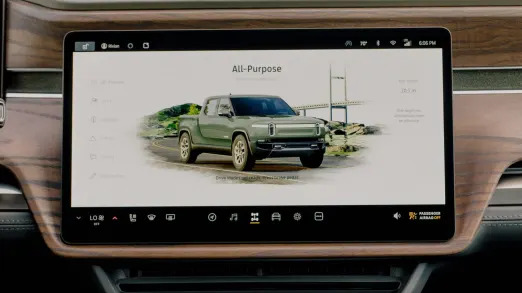
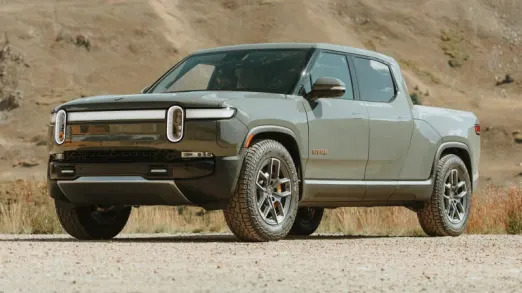
Indeed the R1T does have a number of driving modes. At a high level, there are five self-explanatory ones: All-Purpose, Sport, Conserve, Off-Road and Towing. Among these, Sport has a Launch sub-mode wherein the estimated 3.0-second 0-60 mph acceleration time resides. Off-Road has four subcategories: Auto, Rock Crawl, Rally and Drift. Each of what amounts to nine modes can have a different adaptive damping map, roll stiffness strategy and accelerator sensitivity, and most offer different default and optional height settings from among the five drivable choices: Max, High, Standard, Low, Lowest.
It’d take a Powerpoint presentation to sort through the permutations, so I’ll summarize:
- All-Purpose is the default mode that starts in Standard and drops to Low at freeway speeds to reduce drag.
- Conserve offers more efficiency by prioritizing the front motors, dropping to Lowest mode while cruising and dialing the AC back.
- Sport stiffens everything and also drops to Lowest at highway speeds.
- Off-Road Auto and Rock Crawl start in High and offer Max as an option, but Rock Crawl offers maximum articulation.
- Off-Road Rally and Drift start at Standard and offer High as an option, but Drift biases torque to the rear and permits more speed differential between front and rear axles.
Towing is the one mode I couldn’t play with. I didn’t have a trailer, and this mode self-selects (and deactivates the rear parking sensors) when you plug one in. Towing offers load-leveling but it does not lower at cruising speed — presumably to maintain the preload of your load-equalizing hitch (recommended if you’re towing over 5,000 pounds). The R1T will automatically detect electric trailer brakes and bring up a screen where you can set the gain of the built-in trailer brake controller, but there are no physical pinchers to manually engage the brakes as you test your gain setting. You do that by pressing the thumb-wheel on the right-hand spoke of the steering wheel. That's not the only atypical interior control one has to get used to.
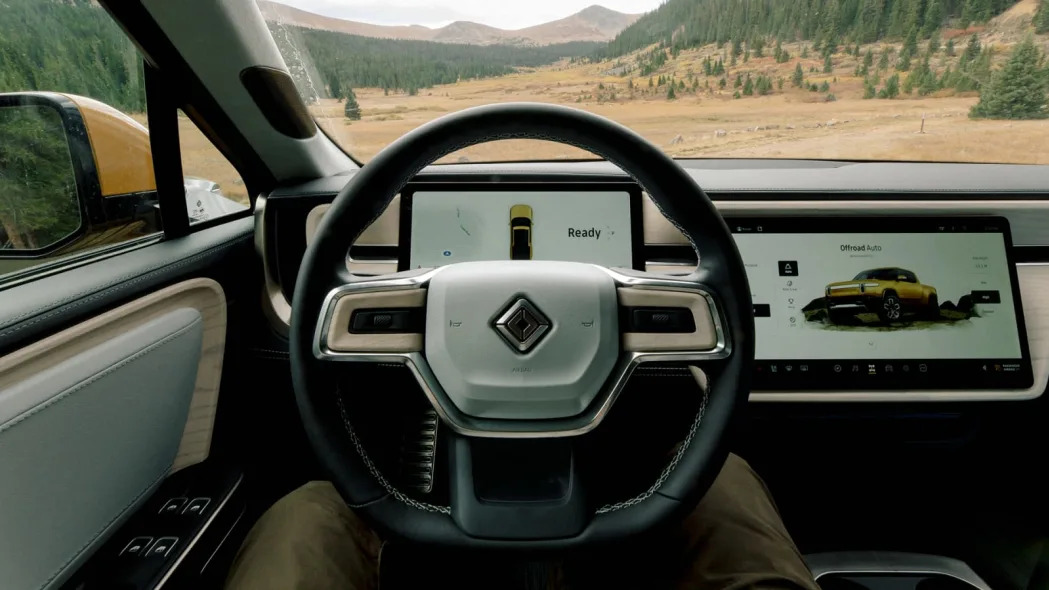
I got out of step with the R1T’s cockpit when I first adjusted the mirrors and steering. You make adjustments with a pair of “multi-functional thumb controls” on the steering wheel spokes, but only after selecting the driver profile menu on the touchscreen and choosing mirror or steering column mode. Adjustments are saved to your driver profile, and the steering/mirror adjustment screen does pop up if you tweak your seat controls, but it’s a cumbersome way to make casual adjustments every time you shift position. The same thumb controls are reused for a wide variety of other situational tasks, too. This approach, similar to that of Tesla, is not our favorite.
The situation elsewhere in the cabin is much better. The interior is generally well-crafted and attractive to look at, and controls such as the thumb buttons are nicely made and give good haptic feedback. There are also real stalks. Logical wiper and headlight controls reside on the left-hand turn-signal stalk. Shifter and adaptive cruise engagement controls are built into the right-hand stalk.
The sizable 16-inch landscape touchscreen has a good deal of shortcut buttons along its perimeter, and drive mode selections are easy to make. But everything is touchscreen-based, with more than a few controls two or three levels down. Two of these came up on the trail: The mirror folding switch was nowhere near the mirror adjustment menu, and the HVAC system’s recirc button was an unwelcome extra layer deep when I was suddenly enveloped by dust.

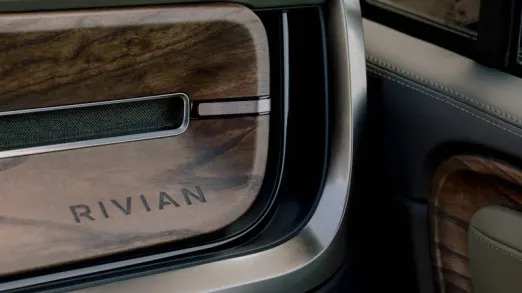
I have similar mixed feelings about the infotainment system, mainly because of limited input choices at launch. The wonderful 1,200-watt, 18-speaker Elevation by Meridian premium audio system sounds outstanding, and you can readily log into your Tune-In or Spotify streaming accounts if you have them. AM/FM and HD radio are available, too. But there’s no Sirius XM if you’re away from cell service, which isn't uncommon while off-roading, and the only way to bring your smartphone into the mix is via Bluetooth streaming audio. Like Tesla products, Apple CarPlay and Android Auto are not supported, and the USB-C ports around the cabin are power-only. Rivian says this was done to maintain complete control of the look and feel of the immersive touchscreen ecosystem, but I think this will tempt drivers to diddle with their phone screens and suction-cup them to a nearby window because they can’t interface with that immersive touchscreen ecosystem.
As for advanced driving systems, Rivian’s approach is a good one. First off, the name itself is Driver+, which correctly implies the driver remains a necessary part of the equation. Furthermore, the top level system that combines adaptive cruise control with active lane centering is modestly called Highway Assist, and it only works on limited-access highways that meet certain criteria. It also includes safeguards such as a capacitive touch steering wheel that makes it hard to fake out the 15-second steering torque timer with a counterweight, as well as driver monitoring sensors that may enable even more capability after future OTA updates are released. The usual accident avoidance and mitigation systems are included, too: forward collision warning, automatic emergency braking, lane-keeping assist, and blind-spot and rear-cross-traffic warning.
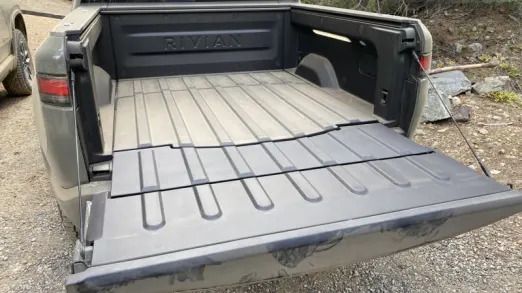

We mustn’t forget about the truck part, and here the R1T goes its own way in a very good way. Its stubby 217.1-inch length is nearly 16 inches shorter than an F-150 Lightning, and its 135.9-inch wheelbase is nearly 10 inches shorter than the Ford's. This combination adds up to a tight turning radius, short front and rear overhangs, and healthy approach, departure and breakover angles. The downside here is the bed is only 54 inches long, which is a half-foot shorter than a short-bed Tacoma’s. But Rivian offers numerous offsetting advantages.
It’s a deep composite bed with a roll-top tonneau cover that locks along with the tailgate when you lock the truck. The bed floor opens to nearly 7 feet long (83.6 inches) with the gooseneck-hinged tailgate dropped open, and there’s a sturdy folding flap that neatly bridges the hinge gap. The front trunk provides another 11 cubic feet of dry, lockable space, and Rivian’s revolutionary truck-spanning “Gear Tunnel” is good for an additional 11.6 cubic feet of the same. The bed floor also opens up to reveal a deep well big enough for the optional full-sized matching 34-inch spare wheel and tire, but that does beg the question of how one is supposed to muscle something that must weigh some 80 pounds up and out of there.
The bed has lighting, power outlets and clip-in attachments for well-engineered factory crossbars. Those of us who air down for off-roading will appreciate the standard air compressor built into the inner wall, and there’s a long hose with a clamp-on filler. Plug one end into the bed fitting and clamp the other to a tire’s fill valve, select the pressure on the screen and hit the Play button. It takes a few minutes per tire, and you have to work your way around the truck, but this is an awesome factory feature. Just below the Play button there are sockets for Gear Guard cables you can loop around cargo or a bike frame. If someone tugs on a cable while the truck is locked, the interior screen lights up with the cartoon shown below to scare them off as the bed-view camera begins to record video.


My drive was too short to verify the 314-mile range that is associated with the R1T’s 135 kilowatt-hour Large Pack battery, but Rivian does not hide the fact that the 34-inch all-terrain tire option will trim that by 10-15%. The rating was made with the standard 21-inch tires in All-Purpose mode and with regen set to the middle Standard setting. The charge cord that comes with the truck has swappable 120V household and 240V NEMA 14-50 ends, and with the latter can draw as much as 7.2 kW through a 32A or higher circuit. The truck’s onboard charger can accommodate 240V flows of up to 11.6 kW if your Level-2 home equipment is sized to take full advantage, and the maximum sustained intake rate at a suitable DC Fast charger is said to be north of 200 kW.
The truck I drove was an Adventure Package, which starts at $73,000. The only other choice is the Explore Package for $67,500. Both come standard with the Large Pack battery, and the bigger Max Pack with an unconfirmed range of 400-plus miles is a $10,000 option. The Pirelli 34-inch all terrain tires are an $1,800 upgrade, but they’ll set you back $3,500 if you want gloss black wheels. Curiously, a full-size matching spare costs $800 either way. An Off-Road Upgrade consisting of reinforced underbody panels and tow hooks costs $2,000, and from there we get into accessories like crossbars, rack accessories for the crossbars, a rooftop tent, a fully-equipped slide out electric kitchen and other miscellany you can peruse on the Rivian website.
Do I wish things were different in terms of certain control and infotainment realities? Sure. But those are the type of things that can evolve for the better as the inevitable OTA updates get pushed out. Overall, it's hard not to be excited about the Rivian R1T's fundamentals after spending a long day pushing it on all kinds of terrain. It’s smartly designed, right-sized and cleverly packaged. It delivers secure performance on the pavement, and effortless capability in challenging off-road conditions. It would obviously be good to sample one on roads and trails that I’m more familiar with, but at this point the R1T has me utterly convinced that electric off-roading is the way to go.
Contributing writer Dan Edmunds is a veteran automotive engineer and journalist. He worked as a vehicle development engineer for Toyota and Hyundai with an emphasis on chassis tuning, and was the director of vehicle testing at Edmunds.com (no relation) for 14 years.
You can find his Suspension Deep Dives here on Autoblog.
Related video:










Sign in to post
Please sign in to leave a comment.
Continue